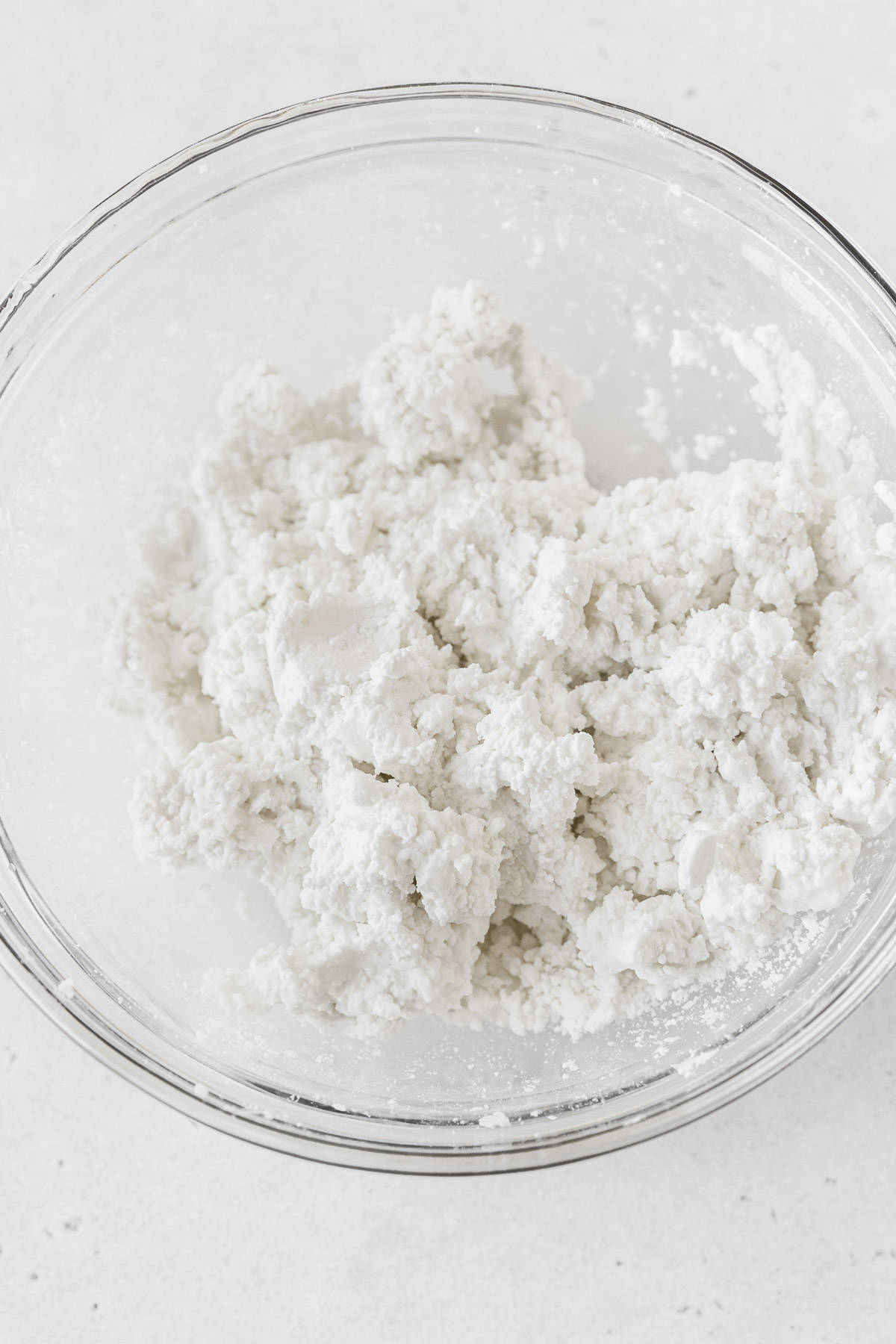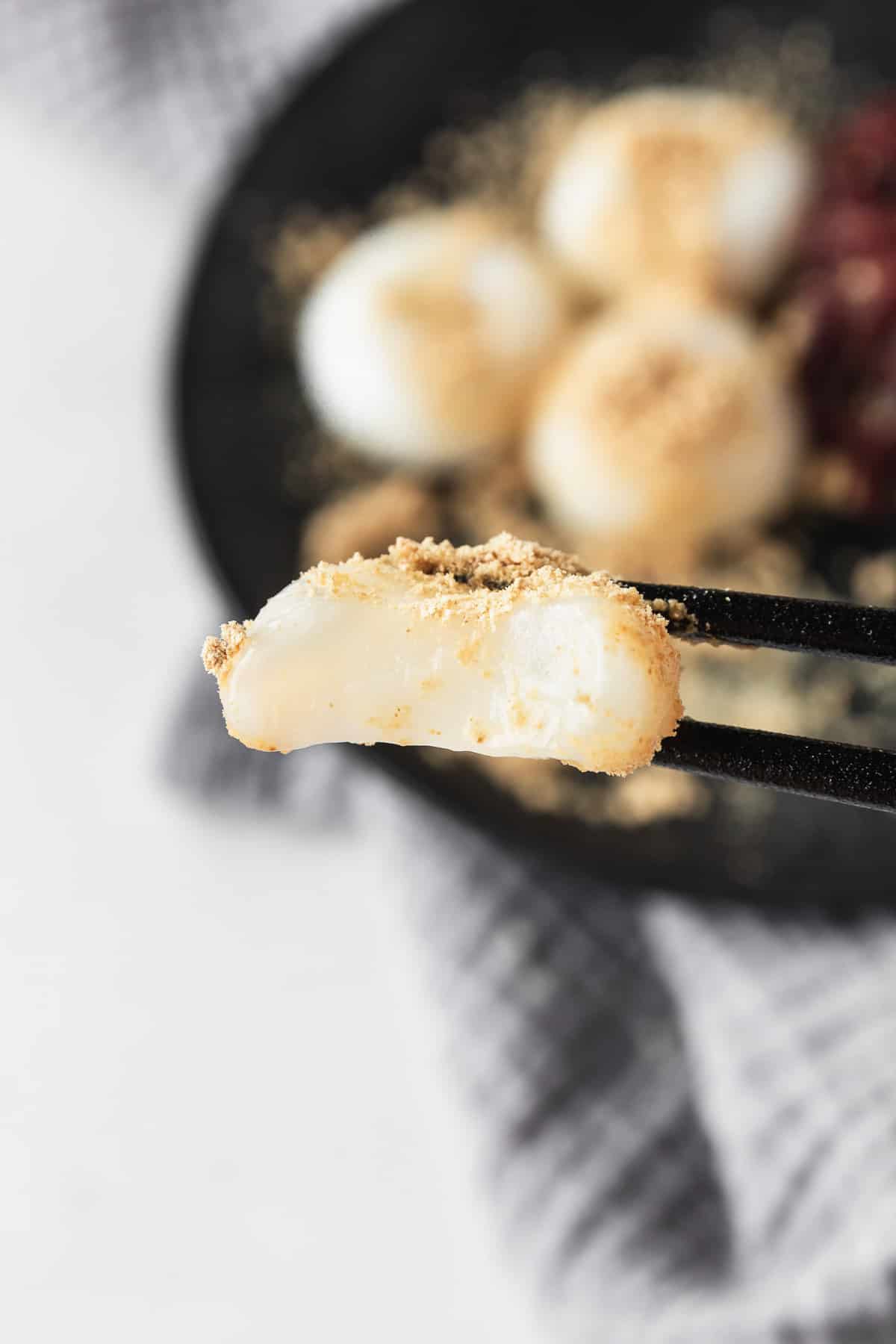If you love Japanese sweets, you're going to love these shiratama dango! They're a type of unsweetened mochi that's often served with sides of red bean paste, kinako powder, or even with a scoop of ice cream.
This recipe was originally published on June 9, 2020. It was updated with new photos and information on January 27, 2023.

Table of contents
- What is shiratama dango?
- What is the difference between shiratamako and mochiko?
- Why you'll love this shiratama dango recipe:
- Ingredients & Substitutions
- How to make shiratama dango:
- How to make this recipe with mochiko rice flour:
- Recipe pro-tips
- Serving suggestions:
- Storage and freezing directions:
- How to soften shiratama dango after storing:
- Frequently asked questions
- Tools needed to make the recipe
- Japanese & Japanese-inspired desserts
What is shiratama dango?
Shiratama dango (白玉団子) is a type of wagashi (traditional Japanese desserts). It has a soft, chewy texture and has a subtle sweetness from the sweet rice flour.
Because of its subtle flavor, it's almost always eaten in combination with something sweet. You can sprinkle some kinako (roasted soy bean powder) and drizzle some kuromitsu (black sugar syrup), put them into a sweet red bean soup called zenzai, or use it as a garnish and textural element on top of ice cream and parfaits! Mmm perfect for the summer!

What is the difference between shiratamako and mochiko?
Shiratamako and mochiko are both types of glutinous rice flour made from mochigome (mochi rice), but they're processed differently.
Shiratamako rice flour is made by grinding polished and rinsed sticky rice, and drying the sediment. Mochiko flour is made by drying pulverized polished and rinsed sticky rice.
Although both are made from the same sticky rice, because the way they're processed differently, they result in different textures of mochi.

Why you'll love this shiratama dango recipe:
Aside from them being utterly delicious, these shiratama mochi are:
- Quick & Easy - It couldn't be more simple to make shiratama dango, as it only requires two ingredients and about 10 minutes from start to finish!
- Not Too Sweet - The substle sweetness of shiratama comes from the sweet rice flour itself so it's not cloyingly sweet.
- Versatile - Because the dango recipe itself isn't sweet, you can serve it with sweet or savory toppings depending on your mood!
- Chewy & Stretchy - The texture is so much fun! If you love soft and chewy textures, you're going to love these.
Ingredients & Substitutions
Like I said, the ingredients for this recipe is very minimal. Here's what you will need:

- Shiratamako - It wouldn't be shiratama dango without this specific type of rice flour!
- Water - To hydrate the sweet rice flour and make it into a dough. Some people prefer to make shiratama dango using soft silken tofu for extra soft dango mochi.
- Toppings - My favorite toppings are sweet red bean paste and kinako!
How to make shiratama dango:
Step 1: In a bowl, add all of the shiratamako and pour in half of the water. Mix well using your hand.


Step 2: Gradually add in the rest of the water and knead with your hand until the mixture is smooth. Fun tip: when making the shiratama dough, we often say to aim for the texture of your ear lobe.


Step 3: Roll the dough into a log and cut it into 24 equal pieces. Using both hands, roll each piece into a ball and place it on a plate with plastic wrap on top to prevent them from sticking to the plate. You can either leave the shiratama as balls or flattened slightly with an indentation made with a finger.


Step 4: Bring a pot of water to a boil and add the shiratama dango. On medium heat, boil the dango until they float to the top, about 4-5 minutes. Continue to cook for 1-2 more minutes.
Step 5: Take them out of the water and put them into a bowl of ice water to chill completely. Once chilled, drain the shiratama and serve them with your topping of choice!


How to make this recipe with mochiko rice flour:
If you'd like to use mochiko instead of shiratamako, I'd start with half the amount of water (¼ cup, or 60ml) and gradually add more to the mixture just until the dough comes together.
Shiratama made with shiratamako has a stretchy and smooth texture, with a shiny surface. On the other hand, those made with mochiko is chewier, less smooth, with a stronger flavor or sticky rice.
Recipe pro-tips
Here are some expert tips on making these mochi dango so they're delicious every time:
- Mix and knead the dough with your hand. It's important to feel the dough with your hand to make sure that the texture is right. Remember, you're aiming for the dough to feel like your ear lobe!
- Wrap your plate with plastic wrap. The dough can (and will) stick to whatever surface you put it on. You can solve this issue simply by adding a layer of plastic wrap on your plate before putting the dough on.
- Add an indentation. Although it's an optional step, adding an indentation to the shiratama will help to cook them evenly, as well as provide a little pocket for your sweet toppings to sit in.
- Don't over boil. Overboiling the shiratama will make them waterlogged and the surface of the shiratama will become soggy.
- Don't keep them in the ice water for too long. Like overboiling, keeping the cooked shiratama sitting in water will also cause them to become soggy. It's best to drain them once they've chilled.

Serving suggestions:
Because shiratama are so subtle in flavor, they're super versatile and can be paired with many different flavorings! Here are some ideas for what to pair with shiratama:
- Sprinkle on some kinako and sugar
- With some anko (sweet red bean paste)
- On top of ice cream (my favorite is matcha ice cream!)
- A drizzle of maple syrup or kuromitsu (Japanese black sugar syrup)
- Added into a sweet red bean soup, called zenzai or oshiruko
- Added into miso soup


Storage and freezing directions:
Take the shiratama and line them up on a piece of plastic wrap leaving ½ inch between each one. Fit the plastic wrap over and around them so they're all covered in plastic and not touching each other. Put this in an airtight container or bag.
Keep the wrapped shiratama in the refrigerator for up to 1 week, or in the freezer for up to 1 month.
Some people suggest to keep them in water, but this causes the shiratama to become soggy and lose its mochi flavor.
How to soften shiratama dango after storing:
Shiratama dango harden in the fridge, so it's important to heat them up before eating them. You can simply heat them up in the microwave, or put into boiling water until they're soft. You can have them warm or put them in some ice water to chill.

Frequently asked questions
No, mochi and dango are not the same. They are both types of Japanese sweets (a.k.a. wagashi) but traditionally, mochi is made by pounding steamed mochi rice (sticky rice) and dango is made from mochi rice flour. Although the distinction is clear in Japan, the term mochi is applied to many sticky rice based desserts outside of Japan.
Depending on the flavor of the dango, it can be served either warm or cold. For example, these shiratama dango are generally eaten cold but another type of dango called mitarashi dango are skewered and grilled before they're served with a sweet soy sauce.
Tools needed to make the recipe

Japanese & Japanese-inspired desserts
If you made my Shiratama Dango recipe, let me know how it turned out by giving it a ⭐️⭐️⭐️⭐️⭐️ rating and comment below! You can also always feel free to tag me on your social posts (@aimadeitforyou) so I can cheer you on from afar.
For more delicious gluten-free, dairy-free recipe inspiration, be sure to follow me on Instagram, Pinterest, Facebook, and YouTube. You can also get all of my newest content delivered straight to your inbox by signing up for my email newsletter.

Shiratama Dango
Ingredients
- 1 cup shiratamako
- ½ cup water
Topping Ideas
- kinako
- sweet red bean paste
- kuromitsu syrup
- maple syrup
- matcha ice cream
Instructions
- Bring a pot of water to a boil. Prepare a bowl of ice water.
- In a bowl, add the shiratamako and pour in about half of the water. Mix well using your hand. Slowly add in the rest of the water and knead with your hand until the mixture is smooth.
- Roll the dough into a log and cut it into 24 equal pieces. Using both hands, roll each piece into a ball.
- Add the shiratama dango to the boiling water. On medium heat, boil the dango until they float to the top. Continue to cook for 1-2 more minutes. Take them out and put them into the ice water to chill completely.
- Once chilled, drain the shiratama and serve them with your topping of choice!
Notes
Nutrition
Links included in this post might be affiliate links. If you purchase a product using these links I may receive a small commission. There is no additional charge to you 🙂



















Leave a Reply